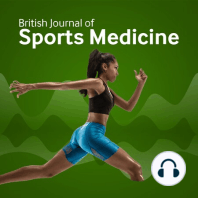12 min listen
Shoulder injuries, with Ann Cools
FromBJSM Podcast
ratings:
Length:
19 minutes
Released:
Apr 23, 2013
Format:
Podcast episode
Description
Babette Pluim (BJSM deputy editor) talks to Ann Cools (professor in the Department of Rehabilitation Sciences and Physiotherapy, Ghent University, Belgium) about her varied research into shoulder injuries.
0.21 Scapular involvement in shoulder pain in overhead athletes
1.32 Treatment strategy of internal impingement in the overhead athlete
3.11 The Scapular Summit 2012
4.49 Eccentric training for shoulder injuries
6.27 Scapula Dyskinesis
8.56 Age related change in the shoulder in tennis players
11.15 Adaptations in scapular movement, subacromial space, and range of movement and strength in elite handball players
15.47 The European Society for Shoulder and Elbow Rehabilitation (EUSSER)
See also:
Descriptive profile of scapulothoracic position, strength and flexibility variables in adolescent elite tennis players http://bit.ly/ZJOhTI
Rehabilitation of shoulder impingement syndrome and rotator cuff injuries: an evidence-based review http://bit.ly/ZJOkyC
Screening the athlete’s shoulder for impingement symptoms: a clinical reasoning algorithm for early detection of shoulder pathology http://bit.ly/15DCSMn
Internal impingement in the tennis player: rehabilitation guidelines http://bit.ly/Y1iEtt
Evaluation of isokinetic force production and associated muscle activity in the scapular rotators during a protraction-retraction movement in overhead athletes with impingement symptoms http://bit.ly/129KBxq
EUSSER www.eusser.org
0.21 Scapular involvement in shoulder pain in overhead athletes
1.32 Treatment strategy of internal impingement in the overhead athlete
3.11 The Scapular Summit 2012
4.49 Eccentric training for shoulder injuries
6.27 Scapula Dyskinesis
8.56 Age related change in the shoulder in tennis players
11.15 Adaptations in scapular movement, subacromial space, and range of movement and strength in elite handball players
15.47 The European Society for Shoulder and Elbow Rehabilitation (EUSSER)
See also:
Descriptive profile of scapulothoracic position, strength and flexibility variables in adolescent elite tennis players http://bit.ly/ZJOhTI
Rehabilitation of shoulder impingement syndrome and rotator cuff injuries: an evidence-based review http://bit.ly/ZJOkyC
Screening the athlete’s shoulder for impingement symptoms: a clinical reasoning algorithm for early detection of shoulder pathology http://bit.ly/15DCSMn
Internal impingement in the tennis player: rehabilitation guidelines http://bit.ly/Y1iEtt
Evaluation of isokinetic force production and associated muscle activity in the scapular rotators during a protraction-retraction movement in overhead athletes with impingement symptoms http://bit.ly/129KBxq
EUSSER www.eusser.org
Released:
Apr 23, 2013
Format:
Podcast episode
Titles in the series (100)
Fiona Bull on seven investments for physical activity: Fiona Bull, professor at the School of Population Health, University of Western Australia, talks Karim Khan through the investments the Global Advocacy for Physical Activity has identified as key for getting more people active. These include public a... by BJSM Podcast
